by Allison Leo | Jul 26, 2019
Mindfulness is the act of creating awareness of your surroundings, emotions, and physical self in the present moment. It helps you connect to the world around you, while providing cognitive, social, and emotional benefits. Practicing mindfulness is not just for adults. Children can reap a multitude of benefits from learning and practicing mindfulness. Mindfulness equips children with the ability to adjust and deal with conflict encountered in their daily lives. It can also help children foster an optimistic outlook in life, react to stress in a healthy way, and develop a positive self-concept.
The practice of mindfulness is foreign to many adults, making it tricky to teach young children. The best thing to do is keep the message simple and model the behaviors you are teaching. Being taught by an adult that models mindful behaviors daily will assist kids in mastering the techniques. Below are a few mindfulness activities you can do at home as a family or in a group learning environment, such as a 4-H club meeting.
Zen Garden
A zen garden is a miniature landscape made with items such as moss,
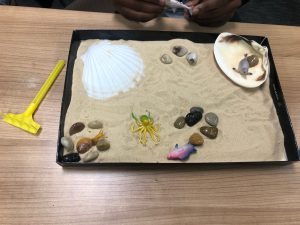
Zen garden created during Leon County 4-H Mindfulness Camp
rocks, and water features. Zen gardens are filled with sand and contain a small rake that you can use to create designs in the sand. The motion of raking the sand creates a sense of calmness. Zen gardens are often found on desks in the workplace because they are known for building focus and reducing stress. Building a zen garden is a fun and easy activity you can do with kids. Use a shoebox lid as the base and collect various stones and other items from outside to fill the box. Small rakes and sand can be purchased at a local craft store.
Mindful Safari
Taking a nature walk around your neighborhood or park is a simple way to exercise your mindfulness skills. Make it exciting by telling them you are going on a “mindfulness safari” and the goal is to see how many different birds, insects, and animals you can find on your journey. By searching for these items, you are fostering an awareness of the world around you. Similar to the mindful safari activity, you can take children on a “sound hunt.” This activity teaches kids to increase their awareness of the sounds in their environment. You can make the “sound hunt” more challenging by asking them to distinguish which sounds are close and which sounds are far.
Breathing
Breathing exercises are an important tool children can use to practice mindfulness. Learning how to control your breath and increase awareness of your breathing can help clear your mind in times of distress. You can practice breathing anywhere and no equipment is needed. Have kids sit on the floor or lie down. Instruct them to close their eye and take a huge breath in, filling up their lungs. Count to three and have them release. Breath activities can be completed sitting or lying down on your back. It is a good practice to have kids place their hands on their belly to feel the breath as it enters and leaves the body.
Mindful Eating
Mindful eating teaches children to understand when they are hungry and when they are full. It is important to eat without distractions, such as the television or your phone. Provide them with a variety of snack items. Ask them to look, listen, touch, smell, and taste the food in steps. They should pause after each step to reflect on what their senses are showing them about their food. First, look at what colors and shapes the item has. Next, listen to see if your food is making any sounds. Then, feel your food and describe the texture. Smell the item and define the scent. Finally, taste the food while paying attention to how the food feels and if the flavors change.
Yoga & Balancing
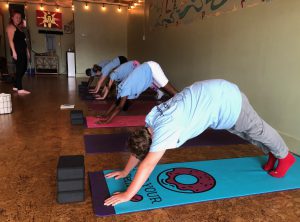
Practicing our “downward dog” pose during Leon County 4-H Mindfulness Camp.
Yoga is a great way to practice concentration, balance, and connection. Kids enjoy trying different yoga poses and stretches. A variety of free educational videos are available online that you can use to help guide you and your child through yoga sequences. Breathing techniques can be coupled with yoga and balancing. If kids do not have a yoga mat, a towel can be used. Practicing yoga shows kids that mindfulness does not always mean you are still or quiet.
Mindful Drawing
It is important to keep distractions to a minimum while drawing. This can be achieved by putting on relaxing music or simple sounds, such as rain falling or waves crashing. There are a variety of different drawing activities you can do with kids to practice mindfulness. If you have different sounds available, you can select a sound and instruct them to close their eyes and think of what that sound looks like to them. Then, have them open their eyes and draw what they heard. You can repeat this activity a few times with different sounds.
Body Appreciation
This activity works best in a group learning environment. Have kids break up into pairs and instruct them to take turns tracing each other on a large sheet of paper. Once everyone is finished, they will focus on their own bodies and write or draw what each body part does for them. For example, they can write “my head helps me think” or “my legs help me run.” Finally, they will write positive words on their body such as “I love to read.” This activity makes kids reflect on all the important ways their body helps them each day. It teaches them to appreciate and love their body.
Gratitude Journal
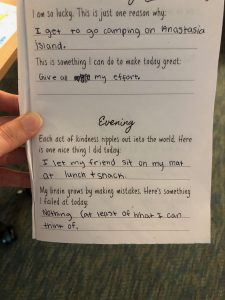
Gratitude Journals are a simple mindfulness activity kids can complete every day
When we feel and express gratitude to people in our lives, it creates loving connections, builds trust, and makes us feel joyful. Gratitude can be shown by giving someone a hug or telling them how much you appreciate them. Gratitude journals can easily be made at home or you can print off a pre-made template. This version is simple and is a great start for kids: https://researchparent.com/gratitude-journal-for-kids/
For more information on how your family can learn more healthy activities such as these mindful ones, find your local UF IFAS Extension Office and contact your 4-H Agent to explore what 4-H programs are offered in your area.
by Allison Leo | Nov 9, 2018
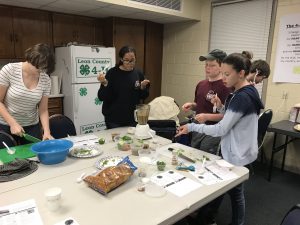
Youth making blender salsa during Leon County’s 4-H Culinary Camp
Are you having a tough time finding kid-approved snacks? With a little extra planning, you can add extra fruits, vegetables and whole grains to your child’s diet. The following snacks can be included in lunch, enjoyed as an after school snacks or as a great addition to any 4-H club meeting!
Stovetop Popcorn
It’s quick, easy, delicious AND a whole grain. Stove top popcorn is delicious just with a sprinkle of salt, but kids can get creative by adding toppings like sugar/cinnamon, Parmesan cheese or lemon zest with pepper. The United States Department of Agriculture (USDA) recommends making half of your grains whole grains each day. Here’s a simple stovetop popcorn recipe for you to try.
Snack Mix
This is another great way to get kids involved in creating their own snack mix using a variety of items. The key is to change it up every few weeks to keep kids interested. Suggested items include: chex mix, dried blueberries, raisins, chocolate chips, walnuts, pretzels, whole grain crackers, popcorn, and more. Use this snack mix recipe as inspiration.
Fruit or Vegetable Kebabs
Kids can help put together this great afterschool snack. For fruit kebabs, try grapes, apples, blueberries or kiwi. For vegetable kebabs, try green peppers, mushrooms, tomatoes or yellow squash. They can be simple with only two items such as strawberry and pineapple or cherry tomatoes and broccoli. You can dip the fruit kebabs in vanilla yogurt or drizzle them with honey. A side of ranch or hummus pairs perfectly with vegetable kebabs. The key is to purchase fruits and vegetables that are in-season to make this snack budget friendly. Here is a resource to find out what is in season in Florida.
Hummus
Let’s be honest, hummus and vegetables might not be at the top of the list of your kid’s favorite snack item. The key is to allow kids to make the hummus and serve it with a variety of items to dip. You can dip carrots, celery, radishes, pretzels, or crackers in hummus. Hummus can be made ahead and stored for a few days sealed tight in the fridge. Here is my favorite hummus recipe.
Blender Salsa
Here’s another fun way to get kids in the kitchen to make a perfect snack for after school. You can put together this recipe in less than 5 minutes – it’s so easy Try this basic blender salsa recipe, but feel free to add your own inspiration by adding extra ingredients.
Smoothies
Endless recipes make smoothies a great after school snack. You can even pack a smoothie for lunch. To ensure the smoothie stays nice and cold, place the thermos in the freezer the night before. In the morning, pour the freshly made smoothie into the frozen thermos. A personal favorite smoothie of mine is: 1 frozen banana, 1 cup milk, 1 scoop of peanut butter, 1 small scoop of cocoa powder and a handful of spinach. The spinach blends right in (you can’t even taste it), and the cocoa powder hides the color of the spinach.
Whole Grain Muffins
Whole grain muffins are an easy snack to make ahead and enjoy throughout the week. Muffins freeze well and still taste delicious when thawed. You can make chocolate chip, strawberry, blueberry, banana, pumpkin and more. Muffins can also be used as a quick breakfast while you are running out the door. For some extra protein, just add some nut butter, such as peanut or almond. Here is a delicious whole grain blueberry muffin recipe.
To learn more about 4-H’s healthy living goal, find your local UF/IFAS Extension office.
by Allison Leo | Aug 24, 2018
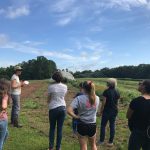 Cooking with Florida Produce
Cooking with Florida Produce
Knowing how to cook and being comfortable in the kitchen is an important life skill that has enduring benefits. Leon County 4-H hosted a culinary day camp with a unique twist: educating youth about Florida produce and local agriculture. In addition to teaching culinary techniques and nutrition, youth learned foundational cooking skills and took things a step further by building connections between local farms and their kitchens.
Teaming up with Fresh from Florida Kids
Chef Paula Kendrick co-led the camp. featuring Florida-grown produce. The importance of nutrition and incorporating healthy foods into the diet was an ongoing theme during the camp. Lessons on how to read food labels, the importance of whole grain and limiting sugar intake were also featured. A salsa cooking competition using local products ended the camp. Chef Paula is from Florida Department of Agriculture and Consumer Services – Fresh from Florida Kids.
Local Farm Highlighted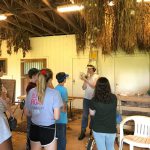
A visit to Full Earth Farm in Quincy helped youth see how a small local farm operates. Owners Katie Harris and Aaron Suko warmly welcomed the group to their farm and gave them a tour. Florida seasonality, composting benefits and how local farms provide fresh produce to businesses and homes in our area were tour highlights. The group left with a box of fresh summer squash to deliver to their next stop – Damfino’s Cafe and Market. Damfino’s sources local products for their menu items. Owner Lucy and Chef Max spoke to the group about their restaurant’s mission of connecting the local community to local farmers.
During the camp, youth were eager to try all the recipes and many of the campers tried new food items for the first time. Fresh herbs from the 4-H garden were used in a number of the recipes. Rosemary was added to honeydew sorbet, and basil was added to sautéed summer squash.
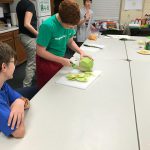 Healthy Eating is Best Learned in the Kitchen
Healthy Eating is Best Learned in the Kitchen
Chef Paula Kendrick shared, “The students got to visit a Florida farm, eat at a local Florida farm to table restaurant and learn how to handle and cook fresh Florida produce. I love helping them to make that farm to table connection while teaching them about Florida agriculture. Cooking is one of the best ways to actually get them to try new things and to understand the importance of healthy eating and nutrition.”
For more information on healthy living 4-H projects such as cooking, contact your local UF/IFAS County Extension Office.







